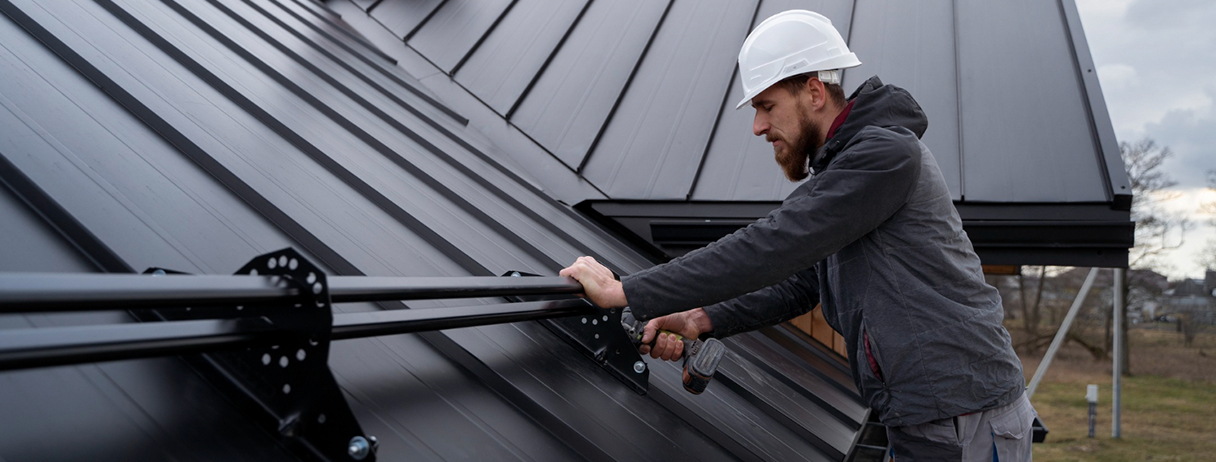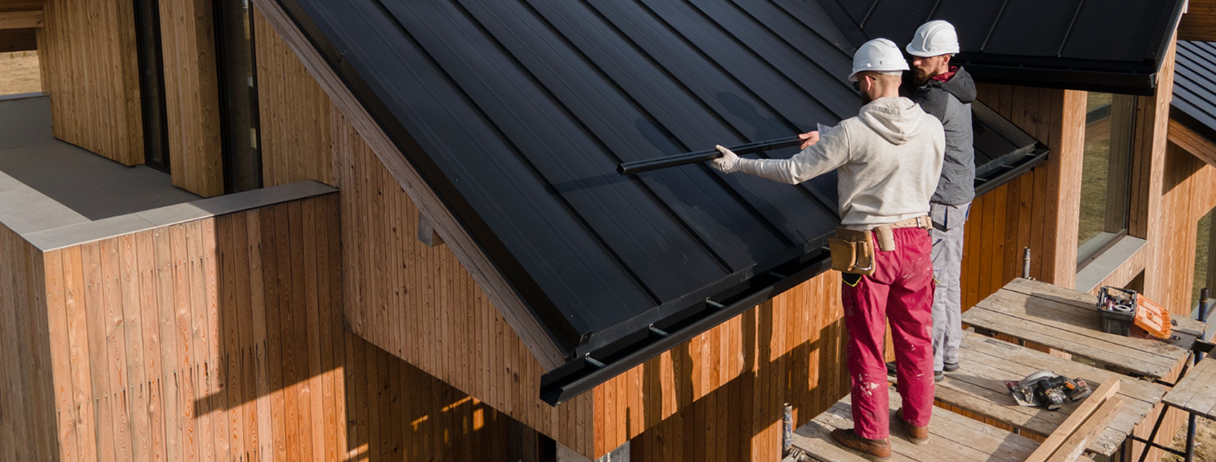The roof is one of the most important parts of a home. It protects you and your family in various ways and adds to the aesthetic appeal of your property. When it comes to choosing the best roofing option for Australian homes, it’s important to consider the wide range of Australian roof types and how they perform in different climates. With advancements in construction, homeowners now have access to modern roofing materials that offer improved durability, energy efficiency, and low maintenance. In this article, we'll take a look at some of the best roofing materials for Australian homes and help you determine which one is right for you.
Roofing Materials For Australian Homes
There are many roofing options available for Australian homes, each with its pros and cons. To determine which option is right for you, consider factors such as cost, durability, energy efficiency, and maintenance requirements. Make an informed decision and choose a roof that will provide you and your family with the protection and comfort you need for years to come.
Terracotta Tiles
Terracotta tiles are classic and aesthetically pleasing roofing materials for Australian homes. They are made from natural clay fired at high temperatures, which gives them a reddish-brown colour. Terracotta tiles are known for their durability, longevity, and resistance to harsh weather conditions. They provide excellent thermal insulation, helping to keep your home cooler in the summer and warmer in the winter. Terracotta tiles can enhance the overall value and curb appeal of your property, making them a great choice for homeowners who value traditional aesthetics and want a long-lasting roofing solution.
Concrete Tiles
Concrete tiles are another popular choice in Australia. They are made from a mixture of cement, sand, and water and can mimic the appearance of various other roofing materials, including terracotta and slate. Concrete tiles are more affordable than terracotta but still offer good durability and weather resistance. They come in a variety of colours and styles, allowing homeowners to achieve the desired look for their homes. Concrete tiles are a suitable option for homeowners seeking a balance between cost, aesthetics, and performance.
Colorbond Steel Roofing
Colorbond steel sheets are modern and versatile roofing materials for Australian homes. It is made from lightweight steel coated with a layer of zinc and aluminium, which provides excellent corrosion resistance. Colorbond roofing comes in a wide range of colours, allowing homeowners to match their roofing with the overall design of their homes. It is known for its durability, low maintenance requirements, and ability to withstand the harsh Australian climate, including strong winds and heavy rainfall. Colorbond steel roofing is ideal for homeowners looking for a contemporary appearance and long-lasting performance.
Slate Roofing
Slate roofing offers a luxurious and sophisticated look to homes. Natural slate is a metamorphic rock that is split into thin layers to create roofing tiles. It is renowned for its elegance, durability, and fire resistance. Slate tiles can last for decades and even centuries, making them a premium choice for homeowners who want a timeless and low-maintenance roofing solution. However, it's worth noting that slate is heavier and more expensive than other roofing materials, so proper structural support is essential.
Polycarbonate Roofing
Polycarbonate roofing is a transparent or translucent roofing material often used for areas where natural light is desired, such as patio covers, pergolas, and greenhouse roofs. It is lightweight, impact-resistant, and offers UV protection. Polycarbonate roofing allows diffused sunlight to enter the space while blocking harmful UV rays. Homeowners looking to create well-lit outdoor spaces can benefit from polycarbonate roofing's unique properties.
Solar Tiles
Solar tiles are an innovative roofing solution that combines energy generation with roofing material. These tiles are designed to look like traditional roofing materials while harnessing solar energy to generate electricity for your home. Solar tiles are an eco-friendly option that can help reduce electricity bills over time. They are suitable for environmentally conscious homeowners who want to invest in renewable energy technology without compromising the aesthetics of their homes.
Metal Roofing
Metal roofing is a popular choice in Australia due to its durability, longevity, and low maintenance requirements. It comes in various materials like Colorbond steel, zincalume, and aluminium. Metal roofs are highly resistant to harsh weather conditions, including heavy rain, strong winds, and even bushfires. They reflect sunlight, helping to keep your home cooler during hot Australian summers, which can contribute to energy savings. Metal roofing suits a variety of architectural styles, from modern to traditional. It's a lightweight material, which can be particularly beneficial for homes with weaker structures. Additionally, metal roofing is recyclable, making it an environmentally friendly choice.
Green Roofs
Green roofs, also known as living roofs or eco-roofs, are gaining popularity among environmentally conscious homeowners. They involve planting vegetation on the roof surface, which provides insulation, reduces heat absorption, and enhances the aesthetic appeal of your property. Green roofs can help regulate indoor temperatures, reducing the need for excessive air conditioning during summers and heating during winters. However, green roofs require careful planning and maintenance. Homeowners should consider factors such as the type of plants suitable for their climate, the weight-bearing capacity of their roof structure, and the irrigation system needed to keep the vegetation healthy.
Copper Roofing
Copper roofing is a premium option that offers both elegance and durability. Over time, copper develops a distinct patina that adds character and unique aesthetics to your home. This material is known for its longevity and resistance to corrosion, making it suitable for Australia's diverse weather conditions. Copper roofing is particularly well-suited for homes with historical or upscale architectural designs. While it comes with a higher initial cost, the long-term benefits and the visual appeal can make it a worthwhile investment. Keep in mind that the installation of copper roofing requires skilled professionals to ensure proper sealing and proper weatherproofing.
Composite Shingles
Composite shingles, often made from a mixture of materials like asphalt, fibreglass, and recycled materials, offer a budget-friendly roofing solution for homeowners. They come in various styles and colours, mimicking the appearance of traditional roofing materials like wood shakes or slate tiles. Composite shingles are relatively easy to install and maintain, making them practical roofing materials for Australian homes. However, composite shingles might have a shorter lifespan compared to some other roofing materials, and their resistance to extreme weather conditions can vary depending on the quality of the shingles. Regular inspection and maintenance are essential to ensure their longevity.
Roofing Colour Trends for Australian Homes
Roof colour plays a significant role in both the aesthetic and functional aspects of Australian homes. Popular choices today reflect a mix of style preferences and climate considerations, with an emphasis on energy efficiency, especially in hot areas.
- Light Grey and Charcoal: Light grey has been particularly preferred for its heat-reflecting capabilities, something particularly important to homes in Australia. Charcoal is somewhat darker and in one way or another, it’s just as stylish as grey while being slightly more heat-absorbent. Both options fit well into a minimalist contemporary style and can be used in any architectural design from beach houses to city apartments.
- Terracotta and Red: Earthy tones such as terracotta and red are predominantly used and preferred for distinctive Mediterranean, colonial, or heritage building designs. They are able to retain more heat than those lighter colours but they add a classic, country feel which is perfect for the Australian countryside or by the beach.
- Black and Dark Blue: Dark colours such as black or dark blue are preferred as they are impressive in nature and go well with modern or industrial-styled homes. They stand well against the light-coloured walls and give the house a good aesthetic appeal. But they retain more heat, and thus such colours are suitable for colder areas.
- Beige and Cream: These colours are common due to their traditional and non-gaudy appearance and also serve the important factor of being heat reflective and therefore are energy-wise choices in hotter areas.
Roofing Materials for Different Australian Climates
1. Coastal Climate:
Beaches along the coasts are more vulnerable to salt water, humidity, and extreme wind—factors that are known to corrode most roofing materials. In these regions, corrosion resistance is most important.
- Metal Roofing (Colorbond or Zincalume): These are excellent metal roofing materials, especially when protected from corrosion by external layers. Metal roofs are also wind-resistant and immune to the fog and salt content prevalent in marine atmospheres, making them a durable choice for coastal climates.
- Concrete or Clay Tiles: These roofing materials offer relatively good durability, providing considerable protection against the tough coastal climate. Although they may occasionally require maintenance to remove salt and debris accumulation, they are not easily corroded.
2. Tropical Climate:
Tropical regions experience extreme heat, constant rain, and sometimes cyclones. Roofing materials here need to withstand pressure from rain and moisture, strong winds, and also provide good insulation.
- Colorbond Steel: This metal roofing material is perfect for tropical climates because it can efficiently shed rainwater, resist heavy downpours, and endure moderate gusts of wind. The steel roofing design is highly durable and does not rust easily in the humid tropical environment.
- Concrete or Clay Tiles: Both of these materials allow rainfall to slip off and afford natural ventilation, helping to keep the house cool in hot, tropical climates.
3. Arid Climate:
Arid climates are characterized by high temperatures, low humidity, and significant temperature differences between day and night. Roofing materials in these areas must be able to shed heat and provide insulation to minimize cooling needs.
- Metal Roofing (Colorbond or Zincalume): Metal roofing materials like aluminium reflect heat, helping to keep the home cooler in dry, arid regions. This makes them an ideal choice for minimizing heat buildup.
- Terracotta Tiles: Known for their excellent thermal performance, terracotta tiles can help keep internal temperatures low during hot months, providing a good balance of insulation in arid conditions.
4. Alpine Climate:
In alpine areas, roofing must withstand heavy snow, ice, and low temperatures. The roofing materials must support snow loads and provide adequate insulation.
Metal Roofing (Steel or Zincalume): Steel roofs, in particular, are strong enough to bear the weight of snow and shed it effectively, preventing the formation of ice dams. The sleek design of metal roofing ensures that snow slides off without accumulating, making it a practical choice for alpine regions.
- Slate Roof: Slate is a premium roofing material that never deteriorates and has the strength to support snow. It also offers excellent thermal insulation, which is essential for homes in cold alpine climates.
- Every climate: in Australia presents unique challenges, and choosing the right roofing material, whether it's metal roofing, slate, or various other roofing materials, is key to ensuring a home is protected from harsh conditions. These choices contribute to energy efficiency, durability, and the overall safety of the building in the respective climate.
Fire-Resistant Roofing Options for Bushfire-Prone Areas
Since many places are prone to bushfires, materials, especially roofing materials, that are resistant to fire should be chosen to prevent losses. Roofs are particularly exposed as embers from the bushfires can easily fall on them, causing another fire outbreak. This way, the owners can dramatically minimize the chances for fire to spread to their homes.
Anything that comes with metal roofing is among the best. It is fire resistant as well as heat resistant in its nature. Furthermore, metal roofs can also afford protection from fire by ordinary airborne sparks and embers. Another good type of roofing is slate roofing. This is a natural stone, and it’s fire resistant in addition to being hardwearing.
However, it should be noted that homemakers can do even more to protect themselves and their families. Having chosen a type of roofing material, it is necessary to take measures. There is also a need to use fire resistant gutters and see to it that no branches are hanging over the roof.
In total, ordinary fire-resistant roofing and the measures described above will be able to save lives and property in territories affected by the threat of bushfires.
Roofing Options That Minimize Noise
If you wish, for example, to reduce noise incidences like rain impacting the roof or hail impacting the roof, then there are specific roofing materials that work well in addressing your issue. At the same time, asphalt shingles and rubber roofing are less noisy than metal roofs because they are precisely sound-insulating. Though long-lasting, clay or concrete tiles may afford some noise reduction but they are heavier than you’d prefer. To get even more quieting outcomes, you may think about insulating the location below the roof with soundproofing material.
Common Factors To Consider When Choosing Roofing Materials For Australian Homes
When choosing roofing materials for Australian homes, consider factors such as your budget, the architectural style of your home, climate conditions in your area, maintenance requirements, and long-term durability. It's also a good idea to consult with roofing professionals to get personalised recommendations based on your specific needs and preferences. Here are some common factors to consider when making your decision for roofing options in Australia:
- Climate and weather conditions: The climate in your area plays a significant role in determining the type of roofing solution that is most suitable. Some materials may perform better in extreme heat, while others are more resistant to heavy rainfall, snow, or high winds. Consider the local weather patterns to ensure your roofing can withstand the elements.
- Budget: Roofing projects can vary widely in cost, depending on the material and complexity of the design. Set a realistic budget and try to find roofing solutions that fit within your financial means. Remember that investing in higher-quality materials upfront can save you money in the long run through reduced maintenance and repairs.
- Roof slope and design: The slope and design of your roof can influence the roofing material options. Some materials are better suited for flat roofs, while others work well with steeply pitched roofs. Ensure the chosen roofing solution is compatible with your roof's design.
- Energy efficiency: If energy efficiency is a concern for you, consider roofing materials that offer good insulation and reflectivity. Some modern roofing solutions can help reduce energy consumption by keeping the interior cooler in hot weather and better insulated during colder months.
- Longevity: Evaluate the expected lifespan of the roofing material you choose and check the warranty provided by the manufacturer. A longer-lasting roof with a solid warranty gives you peace of mind and reduces the need for premature replacements.
The Lifespan of Different Roofing Materials
Type of roofing material |
Expected lifespan |
|---|
Asphalt shingles |
15 to 30 years |
Metal (aluminium, steel) |
40 to 70 years |
Clay tiles |
50 to 100 years |
Concrete tiles |
50 to 100 years |
Slate |
75 to 200 years |
Wood shingles |
25 to 40 years |
Copper |
70 to 100 years |
Why Is Getting Roofing Material Ideas From A Roofer Suggested?
- Expertise:
Roofers have practical experience of years and they know how various materials, such as tile roofs, roofing sheets, and metal roofs, perform in different circumstances. This will assist them in offering you the material that will effectively stand the rigours of your area’s weather conditions, including hail storms, snow, or summer heat, for your roof to last longer as desired and work perfectly well. The recommendations they give are based on real-world experience, not just theory, ensuring your roof is built to withstand the elements.
- Material Quality:
Roofing contractors are familiar with all the available materials in the market, from tile roofs and roofing sheets to metal roofs and slate roofs. They can recommend quality products that suit your specific requirements, being in direct contact with the manufacturer. Thus, by relying on experts, you avoid purchasing low-quality supplies that may seem cheaper at first glance but need frequent replacements, which is unprofitable in the long run.
- Cost Efficiency:
A roofer will assist in striking a balance between the expenses involved and the quality that needs to be delivered. They understand the market price for various materials, including tile roofs, metal roofs, and roofing sheets, and can advise where more affordable options can be found that fit your home. They know how to budget more efficiently, ensuring you don't overspend on unnecessary materials that won’t serve your home optimally in terms of durability and efficiency.
- Proper Installation:
Certain roofing materials, like tile roofs and metal roofs, require additional tools and skills during installation. Roofers can advise on materials that harmonize with the home’s structure and are less costly to install due to their simplicity or compatibility. Their expertise ensures that the roof installation, whether with roofing sheets, metal roofs, or tile roofs, is done correctly, maximizing the longevity and effectiveness of both the materials and the roofing system.
- Local Building Codes:
Roofers are well-informed about the local building codes that approve specific roof materials in a given area. They can assist you in choosing the correct product, whether it's a tile roof, metal roof, or roofing sheets, ensuring compliance with local regulations. This not only helps you avoid costly penalties or delays but also guarantees that your roof meets the legal standards, so your insurance will cover any potential damage.
- Energy Efficiency:
Roofers can recommend to you good materials that can make your home more energy efficient. Specific types, such as cool roofing, or those that use shiny materials in the roofing shingles, lower heat absorption making your home cooler in summer. This leads to such effects as saving on energy that leads to low cost of air conditioning. Roofers can advise clients on ways and means by which they can make a positive change in terms of energy consumption by the home at a cost within their estimates.
- Aesthetic Guidance:
Compared to other workingmen, a roofer even considers more than the utility of the structure but looks at beauty as well. They will advise you when choosing roofing materials that will blend in with the architectural design of your home; if you prefer the conventional style or the contemporary one. Their input enables you to choose the right combination of colours, textures, and materials that attract the eye and improve curb appeal, enhancing your house value within your style choice.
Local Regulation And Aesthetics
Roofing materials for Australian homes must adhere to regionally specific building codes. The typical roofing materials are Terracotta or Concrete tiles, Slate, and Colorbond steel. The materials used must be resistant to inclement weather and are robust. You should choose such types of roofing solutions that harmonize visually with your home’s architectural style and with the surrounding area.
- Compliance With Building Codes: To guarantee environmental requirements, safety, and durability, construction projects must follow building codes in Australia. States have different local laws but above all, the National Construction Code (NCC) establishes the basic standards. By addressing structural integrity, accessibility, and fire safety, the NCC mandates foster a secure built environment. Sustainable practices are aligned with compliance with energy efficiency regulations, such as Nationwide House Energy Rating Scheme (NatHERS).
- Architectural Harmony: Highlighting cultural sensitivity and contextual integration, Australian Design places high importance on Architectural Harmony. Some features are frequently incorporated for artistic coherence, like climatic responsiveness, indigenous influences, and vernacular features. Sustainability is a key theme with designs that use energy-efficient solutions and eco-friendly materials. Fostering a unique Australian architectural style, local aesthetics celebrate a blend of regional identity and modernity. Your functional requirements and aesthetic sensitivities are satisfied when a commitment to a sustainable and harmonious urban landscape is reflected in the built environment. Everyone should be thanks to the collaborative efforts between the regulatory organizations, builders, and architects.
Cost Considerations From Local Roofer Or As Per Australian Regions
Depending upon the material quality and regional conditions, the cost of roofing alternatives can differ in Australia. In some areas, like cyclone-prone areas in the north, durable materials like Colorbond steel may be preferred, even if they can be quite pricey initially. In more temperate climates, standard materials like terracotta or concrete tiles may be more affordable options. Local roofers may offer competitive rates, but it’s important to be sure they are qualified and knowledgeable about the roofing materials that work well in the area.
Costs are affected by various factors such as labour, prices, materials, and extra features such as ventilation and insulation. A thorough analysis of quotations from several nearby roof restoration experts may provide the typical price in a certain region. While making decisions, long-term factors like maintenance and energy efficiency should also be taken into account.
Ultimately, a balance between the longevity of the roofing solution and a balance between upfront expenses should guide the choice, guaranteeing both durability and affordability based on the particular circumstances of the location.
Conclusion
Choosing the right roofing option for your home is a crucial decision that balances aesthetics, durability, and budget. Each roofing material has its unique advantages, from timeless charm to eco-friendliness, you can build your roof with all features. Consider your climate, maintenance preferences, and long-term goals to make an informed choice that ensures your home stays protected and beautiful for years to come.











